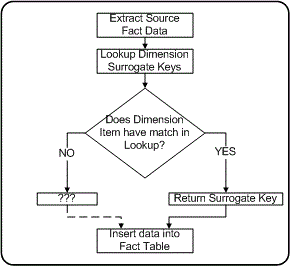緩時變維度(Slowly Changing Dimensions, SCD)
當 OLTP 資料庫中的資料發生變更時,如何在 DW 中適當的反應出這個資訊,這就是緩時變維度要解決的問題。 例如:因為每個業務員有其所屬的銷售區域,所以我們可以由銷售員的角度,來檢視各區的報表。可是如果這個銷售員轉換了銷售區域,那該時何來處理這樣子的變化,以反應出正確的報表結果。
「緩時變維度」問題是設計 DW 時很常遇到的狀況,在 SSIS 中,你除了可以在 Control Flow 和 Data Flow 中自訂解決方法外, 最簡單的方法,就是直接使用 Slowly Changing Dimension Transformation 來簡化處理緩時變問題。
屬性類別(Attribute Types)
SCD 問題
當一個維度的屬性值被變更時,該用什麼方法來保留這個歷吏記錄,有人就歸納出 Type0 ~ Type6 等幾種不同將況,詳情可參考「What are Slowly Changing Dimensions?」。 不過,其中比較常見的解決方法就只有以下三種:
- Type0:Retain Original。
- Type1(overwrite): 直接使用新資料取代舊資料。
- Type2(add a row): 使用一個新的資料列來表示新的資料。
- Type3(add a column):加入一個額外的欄位,用來區分新值與舊值。
Type1(overwrite)
變更前:
| SalesID | SalesName | SalesRegionID |
|---|---|---|
| 1 | Vito | TP |
變更後:
| SalesID | SalesName | SalesRegionID |
|---|---|---|
| 1 | Vito | KS |
Type2(add a row)
變更前:
| SalesID | SalesName | SalesRegionID | Start_Date | End_Date | Current_Flag |
|---|---|---|---|---|---|
| 1 | Vito | TP | 2013/01/01 | 9999/12/31 (null) | Y |
變更後:
| SalesID | SalesName | SalesRegionID | Start_Date | End_Date | Current_Flag |
|---|---|---|---|---|---|
| 1 | Vito | TP | 2013/01/01 | 2014/12/31 | N |
| 2 | Vito | KS | 2014/01/01 | 9999/12/31 (null) | Y |
Type3(add a column)
變更前:
| SalesID | SalesName | SalesRegionID | SalesRegionID_last |
|---|---|---|---|
| 1 | Vito | TP | TP |
變更後:
| SalesID | SalesName | SalesRegionID | SalesRegionID_last |
|---|---|---|---|
| 1 | Vito | KS | TP |
定義屬性類別(Defining Attribute Types)
為了能夠保留歷吏記錄,所以在開始執行 ETL 之前,你就必須先定義,哪些屬性需要要做歷吏記錄,要使用什麼類型的方式做歷吏記錄。
通常可以將維度屬性分成以下幾種類別:
- Business Key:表示該欄位為商務索引鍵,執行「緩時變維度」轉換時至少需要一個商務索引鍵資料行。
- Fixed:表示該欄位為不可變更欄位。
- Type 1 SCD:可以覆蓋的欄位。
- Type 2 SCD:必須保留歷史記錄的欄位。
「緩時變維度轉換」的屬性設定
在使用 緩時變維度轉換 元件時有以下二個限制必須先知道的:
- 只可以處理 SCD Type1 Type2 的需求。
- 「緩時變維度精靈」只支援與 SQL Server 的連接。
商務索引鍵
使用「緩時變維度」轉換至少需要一個商務索引鍵資料行。

資料行的「變更類型」
針對非索引鍵資料行,「緩時變維度」支援以下四種資料行的變更方法:
- 固定屬性(fixed attribute):指示資料行的值不得變更。
- 變更屬性(changing attribute):指示使用覆寫方式記錄變更。相當於「Type 1」變更。
- 歷程記錄屬性(historical attribute):指示使用新資料列方式記錄變更。相當於「Type 2」變更。
- 推斷的成員( inferred member):指示資料行為推斷的成員。

緩時變維度轉換的「輸出」
「緩時變維度」只接受一個輸入,依據以上設定,在經過轉換處理後,會產生至多六種輸出,讓你可以對不同類型輸出做不同的處理。
- 不變更輸出(Unchanged output):無需更新的資料列。
- 新輸出(New output):新資料列。
- 推斷的成員更新輸出(Inferred Member Updates output):此輸出用於推斷的成員資料列。(流程接:UPDATE 陳述式更新記錄)
- 歷程記錄屬性插入輸出(Historical Attributes Inserts output):符合 Type 2 SCD 資料列。(流程接:先 UPDATE 目前記錄的 ValidTo,再插入新資料列)
- 變更屬性更新輸出(Changing Attributes Updates output):符合 Type 1 SCD 資料列。(流程接:UPDATE 陳述式更新記錄)
- 固定屬性輸出(Fixed Attribute output):此輸出表示設定為不可變更的資料列,但是卻被變更資料了。

推斷成員(Inferred Dimemsion Member)
In data warehouse scenarios, it is possible for fact records to arrive with a source business key that has not yet been loaded in the dimension table. This problem is known in DW jargon as late-arriving dimensions or early-arriving facts.

typical solution is to create inferred members in a dimension table :
- Insert a row in the dimension table by using the source system key, and assign a surrogate key to this member. Mark this record as an inferred member by adding a InferredMemrber column (T/F).
- Use the newly created surrogate key and assign it to the fact record.
- Change the loading process for the dimension to check whether a record was populated as an inferred member. If this is the case, you must treat all the attributes as Type 1 SCD regardless of your specification, except for the surrogate key and the business key.
Using the Slowly Changing Dimension Task
SSIS has a predefined Slowly Changing Dimension Transformation that guides you through multiple steps for creating the complete logic for inserting and updating data for a dimension table.

這個 Slowly Changing Dimension Transformation 轉換元件支援 Type1 和 Type2 。 如果要達到 Type2 支援,這個元件提供二種法:
- 使用一個識別欄位(如:CurrentFlag)來識別該筆資料是否為最新的值,或是過期的資料。
- 使用二個欄位 ValidFrom 和 ValidTo 來區分該筆資料是最新的值還是歷史資料。
在設定好「資料行變更類型」及「是否啟用推斷成員」之後,這個 Slowly Changing Dimension Transformation 會產生六種不同的輸出結果:
- Unchanged output:無需更新的資料列。
- New output:新資料列。
- Inferred Member Updates output:此輸出用於推斷的成員資料列。(流程接:UPDATE 陳述式更新記錄)
- Historical Attributes Inserts output:符合 Type 2 SCD 資料列。(流程接:先 UPDATE 目前記錄的 ValidTo,再插入新資料列)
- Changing Attributes Updates output:符合 Type 1 SCD 資料列。(流程接:UPDATE 陳述式更新記錄)
- Fixed Attribute output:此輸出表示設定為不可變更的資料列被變更資料了。

Effectively Updating Dimensions
要注意的是,雖然 Slowly Changing Dimension Transformation 可簡單快速的產生輸出結果,但是,如果你直接使用 OLE DB Command Transformation 元件去承接以進行資料更新,那麼它會使用效率較差的逐筆更新方式。

沒有留言:
張貼留言